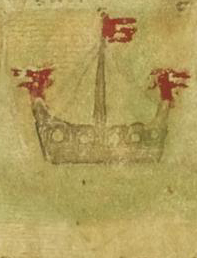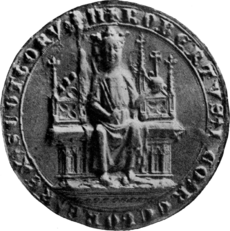Ruaidhrí Mac Ruaidhrí facts for kids
Quick facts for kids
Ruaidhrí Mac Ruaidhrí
|
|
|---|---|
This image shows Ruaidhrí's family name and title from an old book called the Annals of the Four Masters. It mentions the death of a Clann Ruaidhrí member, probably Ruaidhrí, in 1318.
|
|
| Predecessor | Ailéan mac Ruaidhrí |
| Successor | Raghnall Mac Ruaidhrí |
| Died | 14 October 1318? Battle of Faughart? |
| Noble family | Clann Ruaidhrí |
| Issue | Raghnall and Áine |
| Father | Ailéan mac Ruaidhrí |
Ruaidhrí Mac Ruaidhrí (died around 14 October 1318) was an important Scottish leader in the 1300s. He was the chief of a powerful family called Clann Ruaidhrí. Ruaidhrí was a son of Ailéan mac Ruaidhrí.
He took part in many battles against both the English and Scottish kings' supporters. After his brother, Lachlann, seemed to die, Ruaidhrí became the main leader of his family. He strongly supported Robert I, King of Scotland.
Ruaidhrí might be the Clann Ruaidhrí member who died fighting for Robert I in Ireland. This happened at the Battle of Faughart in 1318. After his death, Ruaidhrí's half-sister, Cairistíona, tried to give away their family lands.
Ruaidhrí had a daughter, Áine, and a son, Raghnall. Raghnall stopped Cairistíona's plans and became the new chief of Clann Ruaidhrí.
Contents
About Clann Ruaidhrí
Ruaidhrí was a son of Ailéan mac Ruaidhrí. Ailéan was the son of Ruaidhrí mac Raghnaill, Lord of Kintyre. This older Ruaidhrí gave his name to the family, Clann Ruaidhrí.
Ailéan also had another son, Lachlann, and a daughter, Cairistíona. In Ruaidhrí's time, people in Clann Ruaidhrí started using the family name from their ancestor.
Clann Ruaidhrí was part of a bigger family group called Clann Somhairle. Other parts of this group were Clann Dubhghaill and Clann Domhnaill. Ailéan disappeared from records by 1296, likely dying before then. Cairistíona was supposed to inherit from Ailéan, but her brothers soon took control instead.
Fighting Among Families
In 1296, Edward I, King of England invaded and easily took over Scotland. Many Scottish nobles were captured, including William II, Earl of Ross. He was held prisoner for many years. During this time, Ailéan's sons, Ruaidhrí and Lachlann, gained more power.
Like most Scottish landowners, Lachlann promised loyalty to King Edward I in 1296. Lachlann was married to a daughter of Alasdair Mac Dubhghaill, Lord of Argyll. Alasdair Mac Dubhghaill had supported the Scottish king. So, Edward I used Alasdair Mac Dubhghaill's rival, Alasdair Óg Mac Domhnaill, Lord of Islay, to control the western parts of Scotland.
Fighting soon broke out between these two powerful families. Alasdair Óg complained to King Edward I that Alasdair Mac Dubhghaill had attacked his lands. Alasdair Óg also said he had defeated Ruaidhrí. But Ruaidhrí's promise of loyalty to the English king was just a trick.
Lachlann then attacked Alasdair Óg. Both Ruaidhrí and Lachlann went on to attack the islands of Skye and Lewis and Harris. Alasdair Óg asked Edward I to tell other nobles to help him fight the king's enemies.
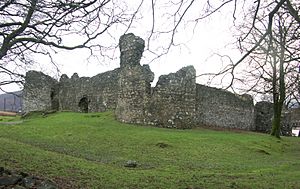
In another letter, Alasdair Óg again asked the English king for help. He complained that he faced a united group. This group included Donnchadh Mac Dubhghaill (Alasdair Mac Dubhghaill's son), Lachlann, Ruaidhrí, and the Comyn family.
Alasdair Óg said that people from Lochaber had sworn loyalty to Lachlann and Donnchadh Mac Dubhghaill. He reported that even though he forced Lachlann to surrender, Ruaidhrí then attacked him.
The Clann Domhnaill chief also described chasing his enemies to Inverlochy Castle. This was a main fortress in Lochaber. There, he destroyed two huge warships. He said they were the biggest in the Western Isles. Alasdair Óg asked the English king for money to fight his many opponents.

Alasdair Óg's letters show that Lachlann and Ruaidhrí wanted to take control of Skye and Lewis and Harris. These islands belonged to the Earl of Ross, who was away. At first, they just raided the islands. But later letters suggest they wanted to own them.
This fierce fighting shows that both families wanted to gain power while the earl was gone. They both wanted to add the islands to their own lands. For Clann Ruaidhrí, these attacks were likely part of a bigger conflict. This conflict started when the area of Skye was given to William II in 1293. As Sheriff of Skye, William II's power covered all of Clann Ruaidhrí's lands.
The letters also show that Lachlann and Ruaidhrí could split their forces. They could fight somewhat separately. If Alasdair Óg defeated one, the other could launch a counterattack.
Lachlann's marriage to a woman from Clann Dubhghaill helped his family. It linked them with the Comyn-Clann Dubhghaill group. This group surrounded the Earldom of Ross.
Supporting or Opposing Robert I
In February 1306, Robert Bruce VII, Earl of Carrick, who wanted to be king, killed his main rival, John Comyn III of Badenoch. Robert Bruce became King Robert I in March. But the English king quickly fought back. Robert I's forces were defeated in June.
By September, Robert I was a fugitive, hiding in the Hebrides islands. An old book, the Gesta Annalia II, says that Ruaidhrí's sister, Cairistíona, helped Robert I survive. She hid him along Scotland's western coast.
Cairistíona's family connections might explain why she supported Robert I. Her husband, Donnchadh, might have been related to the Earl of Mar. Robert I's first wife was the daughter of Domhnall I, Earl of Mar.
The next year, around July 1307, Robert I made a strong comeback. He first took control of Carrick. While Cairistíona helped Robert I, Lachlann seemed to support the English. He promised loyalty to Edward I in August 1306. He also asked for lands that belonged to a supporter of Robert I.
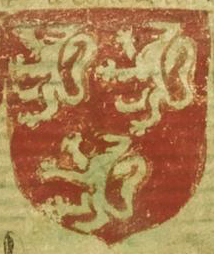
In October, a man named Cristin del Ard delivered messages from the English king. These messages went to William II, Lachlann, Ruaidhrí, and Eóin Mac Neacail. Eóin Mac Neacail was an early member of Clann Mhic Neacail. This family likely lived on Skye and Lewis and Harris.
The Ross family might have made Clann Mhic Neacail an ally against Clann Ruaidhrí. This was after the Skye area was given to William II in 1293. Cristin was close to William II. The English king using William II to send messages suggests the earl had regained influence over these families' lands.
William II played a big part in Robert I's troubles. The earl captured Robert I's wife, Elizabeth de Burgh, and daughter, Marjorie Bruce. He handed them over to Edward I. The messages Cristin delivered might have been about this event. They could show an English effort to gain power in the Isles against Robert I.

Lachlann is last mentioned in records in 1307 or 1308. This was in letters between William II and Edward II, King of England. At that time, William II was in danger. John Comyn, Earl of Buchan, another enemy of Robert I, was defeated by Robert I in 1308.
This strengthening of the Scottish king's power worried William II. He also told Edward II that Lachlann refused to pay the money he owed the English king. William II wrote that Lachlann "is such a high and mighty lord, he'll not answer to anyone." This shows how strong Clann Ruaidhrí was at that time.
It's possible that Clann Ruaidhrí's power helped Robert I gain support in Ross. An old book, the Chronicle of Lanercost, says Robert I received help from the Hebrides. Lachlann and his family had been fighting William II for over ten years. They likely used Robert I's campaign against William II to their advantage.
In 1308, William II surrendered to Robert I. This stopped the attacks from his Clann Ruaidhrí enemies. After Lachlann's last appearance, Ruaidhrí seems to have taken his place as the leader of Clann Ruaidhrí.
In August 1309, Robert I was at "Lochbren." This might be Lochbren near Dingwall, or Loch Broom. If it was Loch Broom, it could mean the king was gathering troops from Clann Ruaidhrí. He might have used them to capture Dunstaffnage Castle from Clann Dubhghaill in October.
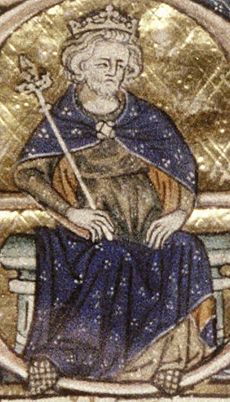
Around 1310, Aonghus Óg Mac Domhnaill was working for the English king. He asked the king to grant lands to some unnamed Clann Ruaidhrí members. These men were helping Aonghus Óg and Hugh Bisset, who were allied with the English. Aonghus Óg believed that if he joined forces with Alasdair Mac Dubhghaill, the English king would have nothing to fear. Another letter from Hugh to the king shows that Aonghus Óg, Eóin Mac Suibhne, and Hugh were all doing naval operations for the English that year.
Who Would Lead Clann Ruaidhrí?
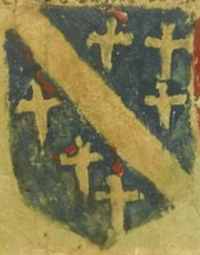
Cairistíona was the only legitimate child of her father. But it's unlikely that the family only cared about legitimate birth for who would lead them. Ruaidhrí was the main male leader of Clann Ruaidhrí at this time. He likely controlled the family's large territories.
However, Ruaidhrí only officially gained his rights after Cairistíona gave up her claims. This was done through a special document confirmed by Robert I himself.
Cairistíona's claim to the leadership, and her close ties to Robert I, might have been a threat to Ruaidhrí and his children. Cairistíona and Donnchadh had a son named Ruaidhrí. He could have asked the king for help to claim his mother's rights. Naming him Ruaidhrí might mean he was seen as a possible future leader of Clann Ruaidhrí.
Cairistíona did give up her claims. But she had a condition: if her brother died without a male heir, and her son married one of her brother's daughters, her son would inherit. This document was likely made early in Robert I's reign, perhaps before 1310.

It's possible that the king arranged Ruaidhrí's leadership to gain support from a powerful family. But Cairistíona, who was a close friend of Robert I, was replaced by Ruaidhrí. This suggests that Ruaidhrí gained control more from family politics than from the king's help.
Either way, Ruaidhrí was probably already seen as the rightful chief. The document made him dependent on the Scottish king. Ruaidhrí's lands included Moidart, Arisaig, Morar, and Knoydart on the mainland. It also included the islands of Rhum, Eigg, Barra, St Kilda, and Uist. This area was as big as any of the kingdom's earldoms.
Death Supporting the Scottish King

There is evidence that Ruaidhrí helped the Scottish king fight in Ireland. He may have died in the big Scottish defeat at the Battle of Faughart on 14 October 1318.
In 1315, Robert I's younger brother, Edward Bruce, Earl of Carrick, invaded Ireland. He claimed to be the high-king of Ireland. For three years, the Scots and their Irish allies fought against the English-Irish. The Scots won every battle except the one at Faughart. This battle was a disaster. Edward Bruce died, and the Scottish rule in Ireland ended.
Old Irish books, like the Annals of Loch Cé, say that a "Mac Ruaidhri ri Innsi Gall" (a Mac Ruaidhrí king of the Isles) and a "Mac Domnaill, ri Oirir Gaidheal" (a Mac Domhnaill king of Argyll) were killed. Other Irish records also mention this. The exact identities of these men are not certain. But they seem to have been the chiefs of Clann Ruaidhrí and Clann Domhnaill. The Clann Ruaidhrí chief was likely Ruaidhrí himself.
Another big battle involving Clann Ruaidhrí was the defeat of Ruaidri Ó Conchobair, King of Connacht. This happened when Feidhlimidh Ó Conchobair defeated him. A man named Donnchadh Mac Ruaidhrí and one hundred gallowglasses (Irish warriors) died with the king. Some records call these gallowglasses "noble."
The next year, in 1317, Clann Ruaidhrí was part of another big defeat. The forces of Connacht defeated those of Bréifne. One record says that 140 gallowglasses of a "Mac Ruaidri" were killed.
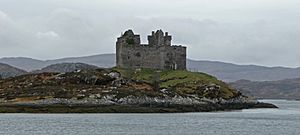
Ruaidhrí seemed to make sure his family would continue. He made peace with Robert I and fought in Ireland with the king's brother. But after he died, Cairistíona tried to take control of the Clann Ruaidhrí inheritance.
Ruaidhrí had a daughter, Áine, and a son, Raghnall. Raghnall might have been too young when Ruaidhrí died. Cairistíona and her allies tried to seize control of the lands. Cairistíona gave up her claimed rights to a man named Artúr Caimbéal after Ruaidhrí's death.
But Raghnall eventually succeeded in taking control of the region. Most of his family saw him as the chief of Clann Ruaidhrí. However, after Raghnall died, these lands went to Áine's husband, Eóin Mac Domhnaill I, Lord of the Isles. He was the chief of Clann Domhnaill.


